Snail sautéed with spices, known as “Ốc xào me” in Vietnamese, is a traditional dish that has been part of the country's culinary culture for centuries.
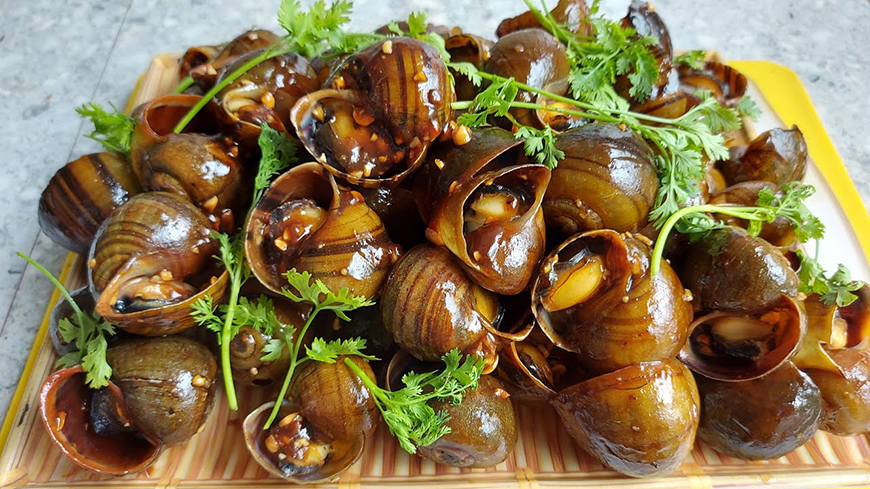
Oc xao me, a traditional Vietnamese dish - Source : internet
Origins and legends
Basically, it's not clear exactly where it comes from. But experts agree that it must date back to the period of Vietnam's old royal dynasties. Back then, people in coastal regions had to make do with what they had on hand, including the snails that were lying around. Little by little, they began to prepare them with spices and condiments typical of the local cuisine.
Incidentally, there's a legend that tells of Emperor Gia Long, founder of the Nguyen dynasty in the 19th century, taking refuge in a village during a period of unrest. To welcome him, the villagers cooked a dish of sautéed snails with all their love and the finest ingredients. The emperor is said to have become completely addicted to them, and they have become a star dish throughout the country!
Snails in Vietnamese culture
But in Vietnam, the snail is not just a matter of good taste. Traditionally, it's also believed to have aphrodisiac and skin-healthy properties. Some even believe that they bring good luck and ward off evil spirits! On a more serious note, the snail is seen as a symbol of perseverance and longevity, because of its slowness but also its ability to regenerate and adapt easily. Qualities that are highly valued in local culture!
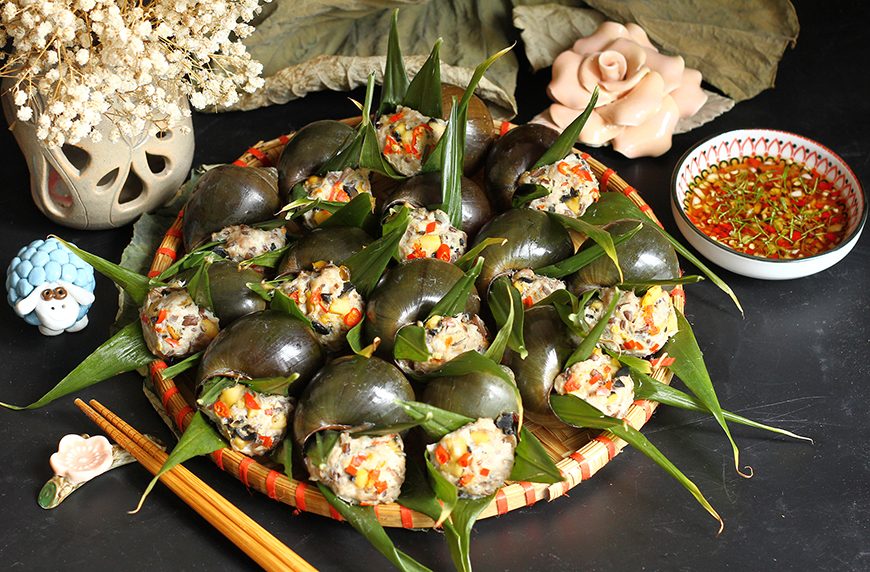
Steamed snails with ginger - Source : internet
The snail, star of Vietnamese cuisine
In Vietnamese cuisine, the snail is a real darling, especially in the center and north of the country. We love it for its unique texture and delicious taste. Here's an overview of how these little creatures are used in Vietnamese cuisine:
Boiled snails (Ốc Luộc)
Imagine snails boiled with aromatic herbs such as lemongrass, kaffir lime leaves, and sometimes ginger. They are often served with a dipping sauce based on nuoc mam (fish sauce), lime, chili pepper and sugar.
Sautéed snails (Ốc Xào)
They can be sautéed with a variety of spices and ingredients such as tamarind, chili, garlic and lemon grass. A classic example: snails sautéed with tamarind (Ốc xào me), where the snails are cooked in a sweet-and-sour tamarind-based sauce (see recipe below).
Noodle soup with snails (Bún Ốc)
This is a rice noodle soup with snails, often accompanied by fried tofu, tomatoes and various fresh herbs. The broth is light but flavorful, often based on tomatoes and fermented shrimp paste.
And of course, they can also be served as appetizers, grilled or cooked in sauces. Some local recipes use snail species specific to Vietnam, such as ốc vặn or ốc hương.
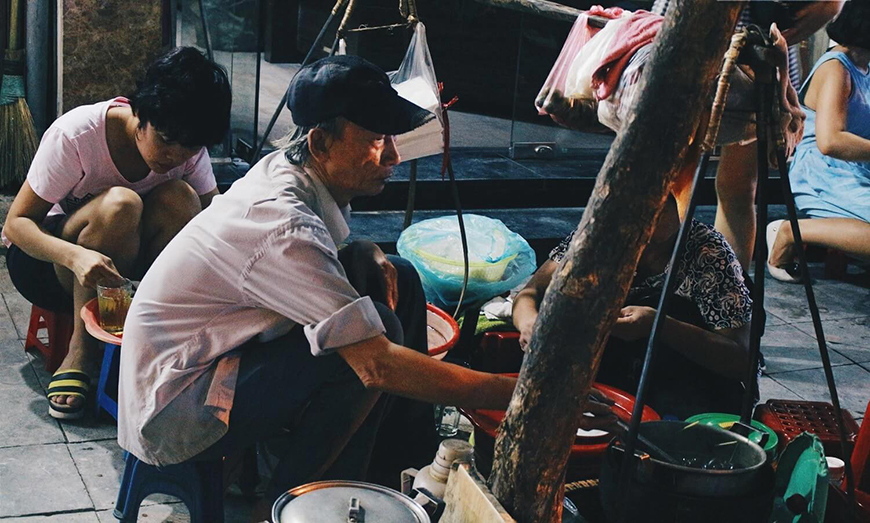
Snails : stars of street food in Hanoi - Source : VinWonders
Holidays where snails are the stars
Têt Nguyên Đán (Lunar New Year)
During the Lunar New Year celebrations, snail dishes are very popular. They symbolize the prosperity, longevity and fertility hoped for in the New Year.
Tết Trung Thu (Mid-Autumn Festival)
During this festival celebrating the harvest and the full moon, families often prepare traditional cakes filled with snail meat. This represents wishes for happiness and abundance.
Lễ Vu Lan (Ghost Festival)
During this Buddhist festival honoring ancestors, snail dishes are served as they are believed to nourish the souls of the departed. This symbolizes respect and gratitude towards past generations.
Lễ Đoan Ngọ (Summer Solstice Festival)
During this celebration linked to seasonal cycles, snails cooked in various ways are widely eaten. This refers to the fertility of nature at this time of year.
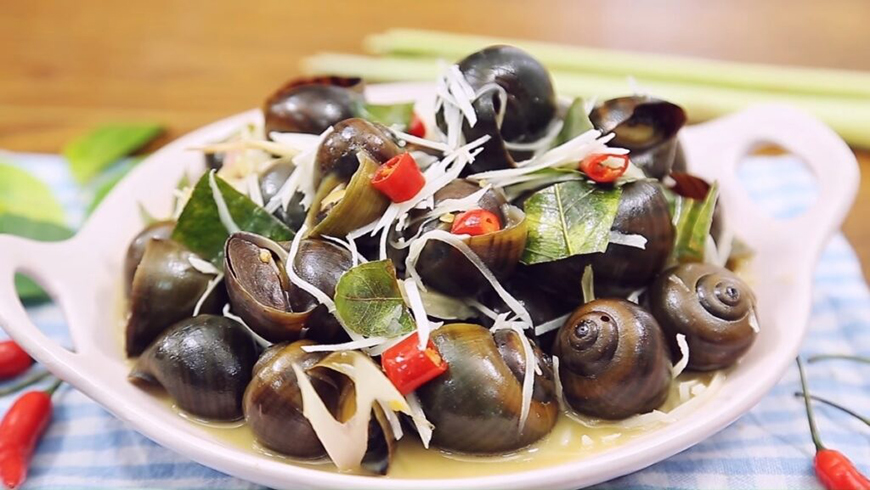
Oc xao me, snails with tamarind sauce - Source : VinWonders
Ốc xào me's original recipe
Ingredients
- 1 kg snails (of your choice, see tips below)
- 100 g tamarind pulp
- 2 tablespoons sugar
- 2 tablespoons fish sauce (nước mắm)
- 2 tablespoons soy sauce
- 3 garlic cloves, finely chopped
- 2 shallots, finely chopped
- 1 chili pepper, finely chopped (adjust according to your spiciness tolerance)
- 1 tablespoon chili paste (optional, for extra heat)
- 1 tablespoon chopped lemongrass (optional)
- Vegetable oil for cooking
- A few Thai basil (rau quế) or coriander leaves for garnish (optional)
Preparation steps
Preparing the snails
1. Cleaning (if needed) :
o Wash snails several times in clean water to remove any impurities.
o Soak them in salted water for a few hours (or overnight) to purge them.
o Rinse snails thoroughly in clean water before use.
2. Pre-cooking :
o Bring a large pot of water to the boil.
o Add the snails and cook for approx. 5-7 minutes.
o Drain the snails and leave to cool.
Prepare the tamarind sauce
3. Prepare the tamarind pulp:
o Soak the tamarind pulp in 200 ml of hot water for about 10 minutes.
o Crush the pulp to extract the juice and strain to remove seeds and fibers.
4. Mixing the sauce :
o In a bowl, mix the tamarind juice with the sugar, fish sauce and soy sauce. Adjust the proportions to taste.
Cooking
5. Sauté the herbs:
o In a large frying pan or wok, heat 2-3 tablespoons vegetable oil over medium heat.
o Add the garlic, shallots and lemongrass (if using). Sauté until fragrant and golden.
6. Add snails:
o Add the pre-cooked snails to the pan and sauté for about 2-3 minutes.
7. Add the sauce:
o Pour the tamarind sauce mixture into the pan.
o Add the chili pepper and chili paste (if you like).
o Mix well to coat the snails with the sauce.
o Simmer for around 5-7 minutes, stirring occasionally, until the sauce reduces and thickens slightly.
Finish
8. Garnish and serve :
o Transfer the snails to a serving plate.
o Garnish with Thai basil or coriander leaves, if desired.
o Serve hot, accompanied by crusty bread or white rice to soak up the delicious sauce.
Enjoy your meal!
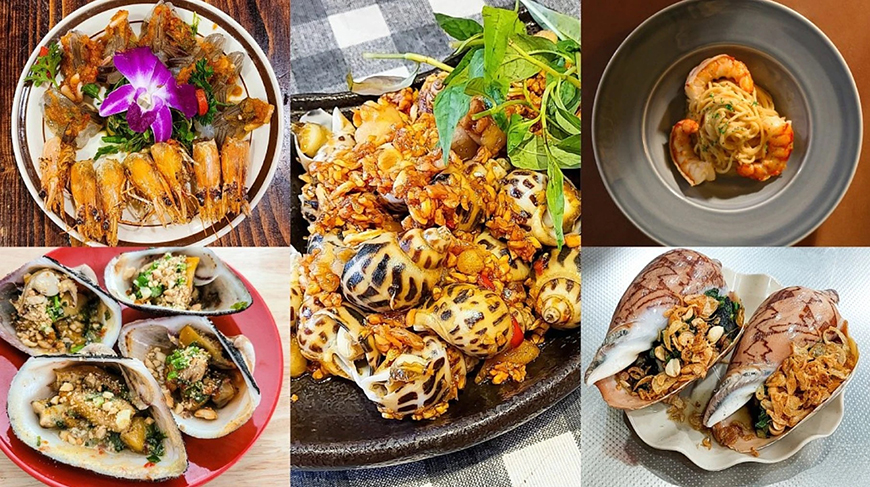
Snails in Vietnamese cuisine - Source : internet
Tamarind substitutes
If you don't have tamarind on hand, you can substitute it with other ingredients to get a similar flavor, but the exact taste won't be the same. Here are some possible substitutes:
- - Lime juice and sugar:Mix lime juice with a small amount of sugar to recreate the acidity and sweetness of tamarind. Use around 2 tablespoons of lime juice and 1 tablespoon of sugar for every 100 g of tamarind pulp.
- - Rice vinegar and sugar: Rice vinegar has a mild sweetness that can replace the acidity of tamarind. Mix 2 tablespoons of rice vinegar with 1 tablespoon of sugar.
- - Plum jam or apricot jam: These jams can add a sweet-and-sour flavor similar to tamarind. Use 1 to 2 tablespoons of jam for every 100 g of tamarind pulp.
- - Worcestershire sauce: Worcestershire sauce contains tamarind and can add a certain depth of flavor. Use sparingly, about 1-2 tablespoons, and adjust to taste.
- - Soy sauce and lemon juice blend: A combination of soy sauce (for depth) and lemon juice (for acidity) can also work. Mix in equal parts and adjust to taste.
- - Honey and balsamic vinegar: For a more complex touch, you can combine honey and balsamic vinegar. The honey adds sweetness, while the balsamic vinegar adds a touch of acidity and caramel notes.
And finally, you can try this mixture:
- - 2 tablespoons lime juice
- - 1 tablespoon brown sugar
- - 1 teaspoon soy sauce
Tips on choosing snails
Burgundy snails (Helix pomatia)
- - The most traditional and authentic option for reproducing the taste and texture of Vietnamese snails.
- - Easy to find in supermarkets or delicatessens.
- - Delicate taste and tender texture, appreciated by gourmets.
Little grey snails (Helix aspersa)
- - Smaller and less expensive than Burgundy snails, these are an economical alternative.
- - With a slightly stronger taste, some prefer them for their more assertive character.
- - Available in markets and sometimes supermarkets.
Woodland snails (Achatina achatina)
- - Less common option, but economical and ecological, as these are invasive snails.
- - With a stronger taste and firmer texture, they require longer cooking.
- - Harvested by private individuals or available from specialized suppliers.